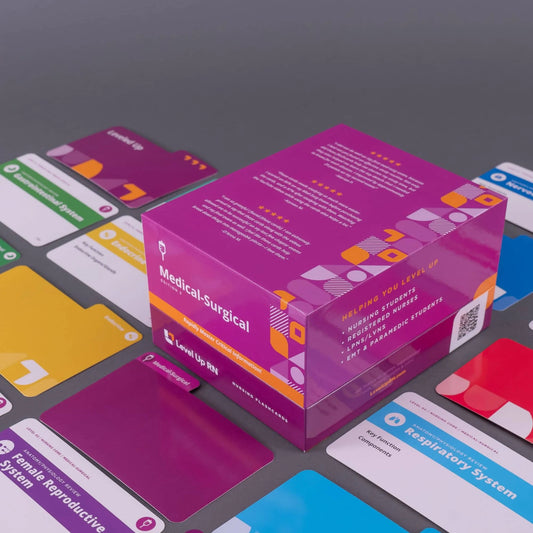Med-Surg - Musculoskeletal System, part 4: Arthroplasty
Updated: Cathy ParkesArthroplasty. The indications and contraindications of the procedure, as well as pre-op and post-op nursing care. Specific post-op nursing care and patient teaching following a knee arthroplasty and hip arthroplasty.
Full Transcript: Med-Surg - Musculoskeletal System, part 4: Arthroplasty
Full Transcript: Med-Surg - Musculoskeletal System, part 4: Arthroplasty
Hi, I'm Cathy with Level Up RN. in this video, I will be talking about arthroplasty. If you have our medical-surgical nursing flashcards available at leveluprn.com, definitely pull those out so you can follow along with me. At the end of the video, I'm going to give you guys a little quiz to test your knowledge of some of the key points I'll be covering in this video. So definitely stay tuned for that.
An arthroplasty is the replacement of a diseased joint with a prosthetic joint, and some of the more common types of arthroplasty include a knee replacement, a hip replacement, or a shoulder replacement.
Indications for this type of surgery include osteoarthritis, rheumatoid arthritis, trauma, as well as congenital defects.
Contraindications for this surgery include an active infection or advanced osteoporosis.
In terms of pre-op nursing care, because this type of surgery does result in a fairly significant amount of blood loss, the provider may want the patient to take epoetin alfa to help boost up their red blood cell numbers prior to the operation, or the patient can provide an autologous blood donation several weeks prior to the procedure that will allow the provider to give a blood transfusion either during or after the procedure if needed. We also need to remind the patient that they will need to shower with an antiseptic soap prior to the operation, and sometimes the provider will prescribe special antibacterial wipes that should be used to help decrease the risk of infection.
In terms of post-op nursing care, no matter what type of arthroplasty the patient had, we want to monitor the patient closely for a thromboembolism such as a DVT or a PE. We also want to take measures to prevent a thromboembolism, so that will include putting SCDs on a patient or applying anti-embolic stockings, administering anticoagulants. In addition, starting exercise and activity pretty quickly after surgery helps to prevent blood clots and actually improves patient outcomes in general. So chances are, physical therapy will be coming to work with your patient the day they had the operation. So patients do not lay in bed for days at a time. They get them up pretty quickly and get them moving.
We also want to monitor a patient for infection, bleeding, and neurovascular compromise. So you definitely want to be checking the patient's pedal pulses, the color of their skin, their temperature, etc.
And then we need to provide some important patient teaching regarding the need to take antibiotics prior to any dental procedure or invasive procedure, so they will need to take these antibiotics prior to those type of procedures for the rest of their life. So that's definitely an important teaching point that you need to make sure your patient understands before they discharge.
Let's now talk about some specific post-op nursing care considerations for a hip and knee arthroplasty.
So following a hip replacement surgery, the patient should have an abduction device in place. So their legs will be spread out like this, abducted, and there will be this triangular-shaped cushion between their legs. And then we also want to make sure our patient's heels are elevated off the bed in order to prevent pressure injuries, and then we should make sure there's a trapeze device applied to the patient's hospital bed so they can grab hold of that and help reposition themselves in bed. We want to be on the lookout for any signs and symptoms of joint dislocation, so this can include the patient telling you that they are having increased hip pain. It could be that the affected leg appears shorter. Or if it's internally rotated, those would be signs of a possible joint dislocation.
In terms of patient teaching following a hip arthroplasty, we want to advise our patient to use an elevated toilet seat. They should avoid low chairs because we want the patient to avoid hip flexion over 90 degrees. We also want to advise our patient to not cross their ankles or legs because this can also cause a joint dislocation.
Okay. So in terms of a knee arthroplasty in post-op care, sometimes the provider will order continuous passive motion. And if that is ordered, you need to place that device on the patient immediately after surgery. You want to make sure in terms of patient positioning that you do not place a pillow or knee gatch under the patient's knee because that can result in flexion contractures. So we want to make sure the patient's leg is straight and that knee is not bent. So no pillow, no knee gatch.
And then we need to teach our patient to not kneel or do any kind of deep knee bends following their knee arthroplasty.
All right. It's time for a quiz. I have three questions for you. First question, why is an abduction device used after a hip arthroplasty? The answer is it helps to prevent joint dislocation. Question number two, following a hip arthroplasty, hip flexion should not exceed blank degrees. The answer is 90. Question number three, following a knee arthroplasty, a pillow should be placed under the knee. True or false? The answer is false.
Okay. I hope this video has been helpful. If so, be sure to like it, leave me a comment. And if you haven't already done so, be sure to subscribe to our channel. Thank you so much for watching.



1 comment
This video helps me a lot. Thanks for the presentation it’s a great job.